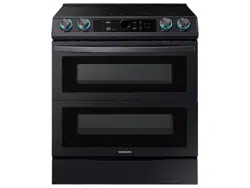Documents: Go to download!
- Owner's manual - (English, French, Spanish)
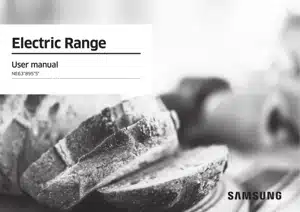
- Surface cooking
- OPERATING THE OVEN
- MAINTENANCE
- TROUBLESHOOTING
Table of contents
Freestanding Electric Range User Manual
Surface cooking
About induction cooktop cooking
CAUTION BEFORE
COOKING
- Do not use the Induction cooktop surface as a cutting board.
- Do not place or store items that can melt or catch fire on the Induction cooktop, even when it is not being used.
- Turn the induction cooktop on only after placing the cookware on it.
- Do not store heavy items above the cooktop surface. They could fall and damage it.
CAUTION
DURING COOKING
- Metallic objects such as knives, forks, spoons, and lids should not be placed on the induction cooktop surface since they can get hot.
- After use, switch off the induction element using its control. Do not rely on the pan detector.
- Use this appliance for normal cooking and frying in the home only. It is not designed for commercial or industrial use.
- Never use the induction cooktop range to heat the room.
- Take care when plugging electrical appliances into a power outlet near the cooktop. Power cords must not come into contact with the cooktop.
- Overheated fat and oil can catch fire quickly. Never leave surface units unattended when preparing foods in fat or oil, for example, when cooking french fries.
- Turn the cooking zones off after use.
- Never place combustible items on the induction cooktop. It may cause a fire.
- Do not use the induction cooktop to heat aluminium foil, products wrapped in aluminium foil, or frozen foods packaged in aluminium cookware.
- There is the risk of burns from the appliance if used carelessly.
- Do not let cables from electrical appliances touch hot cookware or the hot surface of the induction range cooktop.
- Do not use the induction range to dry clothes.
- Never store flammable materials such as aerosols and detergents in the drawer or cupboards under the induction cooktop.
- Users with Pacemakers or Active Heart Implants must keep their upper body at least 1 ft. (30 cm) from the induction cooking zones when they are turned on. If in doubt, you should consult the manufacturer of your device or your doctor.
CAUTION
AFTER COOKING
- Do not touch the Induction elements until they have cooled down.
- The surface can stay hot for some time after cooking is complete. If you touch the surface before it has had time to cool down sufficiently, you can burn yourself.
- Immediately clean spills on the cooking area to prevent a tough cleaning chore later.
- After you have activated elements on the cooktop, the internal fan may come on for cooling purposes.
- The fan activation time may differ depending on the temperature of the internal sensor. (10 minutes or 20 minutes)
- If you have cabinet storage directly above the cooking surface, make sure that the items in the cabinet are infrequently used and can be safely stored in an area subjected to heat. Temperatures may be unsafe for items such as volatile liquids, cleaners, or aerosol sprays.
NOTE
When you operate the knob, beep sounds once.
Location of the induction cooktop elements and controls
The induction control knobs operate the induction surface elements on the cooktop as shown below.
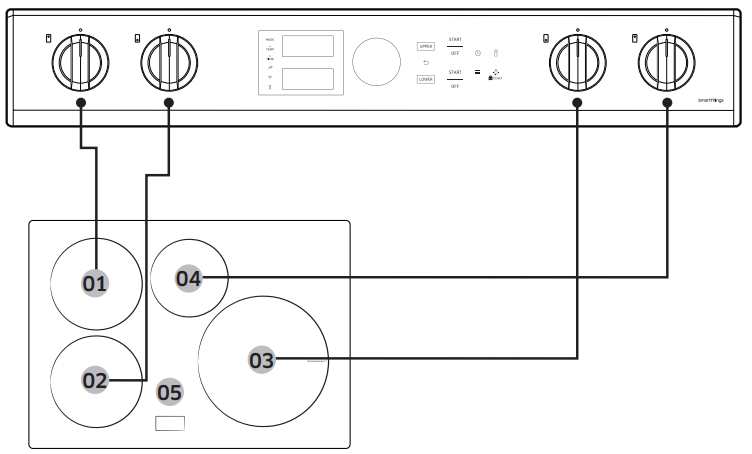
Safety instructions. Residual heat
- The Cooktop display has a residual heat indicator for each element. It shows which elements are still hot. You should avoid touching an element when this indicator is displayed.
- Even if the Induction cooktop is switched off, the
 or
or  indicator will stay lit while an element is still hot. The
indicator will stay lit while an element is still hot. The  indicator is hotter than
indicator is hotter than  .
.
NOTE: The knob illumination around the knob turns on when the knob is turned on.
Digital display
 Power Boost : Use this setting to heat up the contents of a pot or pan faster than the maximum power level "
Power Boost : Use this setting to heat up the contents of a pot or pan faster than the maximum power level " " (Hi).
" (Hi). Displayed if an element knob was set to an On position after the Sabbath or Self-clean mode has ended or been cancelled, and the range was not able to detect a pot or pan on the burner within one minute. To return the display to normal and use the cooktop, set the knob to the Off position.
Displayed if an element knob was set to an On position after the Sabbath or Self-clean mode has ended or been cancelled, and the range was not able to detect a pot or pan on the burner within one minute. To return the display to normal and use the cooktop, set the knob to the Off position. Error message. Displayed if the Induction cooktop has overheated because of abnormal operation. Example : Operating with empty cookware.
Error message. Displayed if the Induction cooktop has overheated because of abnormal operation. Example : Operating with empty cookware. Error message. Displayed if the cookware on an element is unsuitable, too small, or if no cookware has been placed on the cooking zone.
Error message. Displayed if the cookware on an element is unsuitable, too small, or if no cookware has been placed on the cooking zone. ,
,  Displayed when the Sabbath or Self-clean mode is operating.
Displayed when the Sabbath or Self-clean mode is operating.
How to set the appliance for cooktop cooking
CAUTION
- The cooktop elements may be hot even when off and burns can occur. Do not touch the cooktop elements until they have cooled down sufficiently.
- Never leave cooking food unattended when you set the heating element to 6 or higher. Boilovers cause smoke. Greasy spillovers may catch on fire.
- Be sure you turn the control knob to OFF when you finish cooking.
Induction cooktop control knob
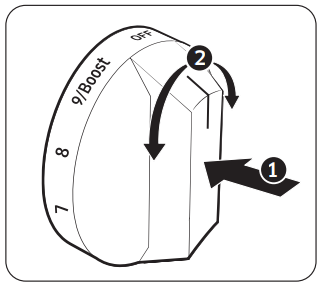
- Push the knob in.
- Turn in either direction to the setting you want.
- The digital displays will show
 or "
or " ". • Move the Knob dial until the desired power level setting appears in the digital display: 1, 2 to 9 (Hi),
". • Move the Knob dial until the desired power level setting appears in the digital display: 1, 2 to 9 (Hi),  (Boost).
(Boost).
NOTE Should one or more of the cooking zones switch off before the indicated time has elapsed, see the "Troubleshooting" section. (page 66)
Induction power boost control

- To use the Power boost setting, turn the control knob directly to the "9/Boost" setting.
- The digital display will show "
 ".
".
- The power boost function makes additional power available to the induction cooking zone when you need it. Example: To bring a large volume of water to a boil.
- The power boost function is activated for a maximum of 10 minutes for each cooking zone. After Power Boost is finished, the cooking zones automatically return to power level "9".
NOTE
- If you turn the control knob to "9/Boost" from another power level, the Induction cooking zone will operate at power level "9". (You cannot set Boost "
 ", if you rotate the knob to the left.)
", if you rotate the knob to the left.) - In certain circumstances, the Power boost function may be deactivated automatically to protect the internal electronic components of the induction element.
Induction simmer control
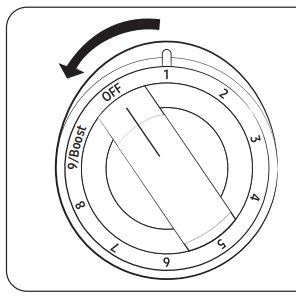
- To use the Simmer setting, turn the control knob to 1.
- The digital display will show "1".
- Use Simmer to simmer and keep large quantities of foods such as stews and soup warm.
- The simmer setting of the small cooking zone is ideal for delicate foods and melting chocolate.
Virtual Flame technology

Virtual Flame technology creates the appearance of flames when you turn on an induction element.
- If the Virtual FlameTM option is set to On, virtual flames appear when you turn an induction control knob to an On position.
- The virtual flame may look different depending on the appearance, size, or position of the cookware. (For the best results, use cookware that matches the element size. Cookware that is too large can cover the virtual flame. Cookware that is too small can cause the virtual flame to be ill-formed.)
- Impurities on the cookware bottom or the cooktop surface can cause the virtual flame to be ill-formed or incomplete. Clean up the cookware or the cooktop surface before using them.
- To turn off the virtual flames, set the Virtual FlameTM option to Off. If the virtual flame function does not operate, check if the Virtual FlameTM option has been turned off.
Before using the cooktop
Use quality cookware in good condition
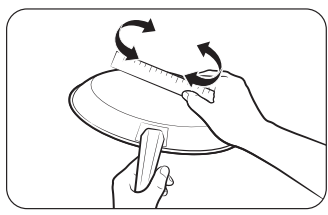
The cookware used with the cooktop surface should have flat bottoms that make good contact with the entire surface of the Cooking Zone. Check for flatness by rotating a ruler across the bottom of the cookware. Be sure to follow all the recommendations for using cookware.
Also remember to
- Use cookware made with the correct material for induction cooking. See "Cookware for induction cooking zones" on page 27.
- Use quality cookware with heavier bottoms for better heat distribution allowing for more even cooking results.
- The pan size should match the amount of food being prepared.
- Do not let pans boil dry. This may cause permanent damage in the form of breakage, fusion, or marring that can affect the ceramic cooktop. (This type of damage is not covered by your warranty.)
- Do not use dirty pans with grease buildup. Always use pans that are easy to clean after cooking.
CAUTION
- The Cooking Zones may appear to be cool while turned ON and after they have been turned OFF. The glass surface may be HOT from residual heat transferred from the cookware and burns may occur.
- DO NOT TOUCH HOT COOKWARE or PANS directly with your hands. Always use oven mitts or pot holders to protect your hands from burns.
- DO NOT SLIDE cookware across the cooktop surface. Doing so may permanently damage the appearance of the ceramic cooktop.
CORRECT | INCORRECT |
 |  |
| Flat pan bottom & straight sides | Curved or warped pan bottoms or sides. |
 | 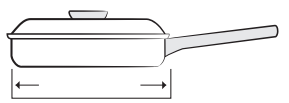 |
| Pan size meets or exceeds the recommended minimum size for the Cooking Zone. See "Using the correct size cookware" | Pan does not meet the minimum size required for the Cooking Zone used. See “Using the correct size cookware” |
 | 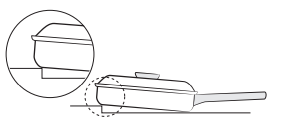 |
| Pan rests completely on the Cooktop surface. | Pan bottom rests on cooktop trim or does not rest completely on the cooktop surface. |
 |  |
| Pan is properly balanced. | Heavy handle tilts pan. |
NOTE:
ANY one of the incorrect conditions listed above may be detected by the sensors located below the ceramic cooktop surface. If the cookware does not meet one or more of these conditions, one or more of the Cooking Zones will not heat, and settings will flash in the affected Cooking Zone display. Correct the problems before attempting to activate the cooktop.
OPERATING THE OVEN
Control panel

- START: Press to start oven operation.
- OFF: Delete all information entered, return to the first step. Stop the oven operation.
- Time Option: Go to set time options. (Cook time, Delay start)
- Options: Go to set options.
- Smart Control: Set Smart Control function On/Off.
- Light: Tap to turn oven light On/Off.
- Dial Knob:
- Turn Clockwise - Move focus to next / increase value.
- Turn Counterclockwise - Move focus to previous / decrease value.
- Push - Select the current value.
- Back: Go to upper depth, previous page, etc.
- Flex duo Oven: Select Upper and Lower oven to use
Lock
This feature lets you lock Oven controls, Cooktop, and Oven door so they cannot be activated accidentally.
How to activate the Lock feature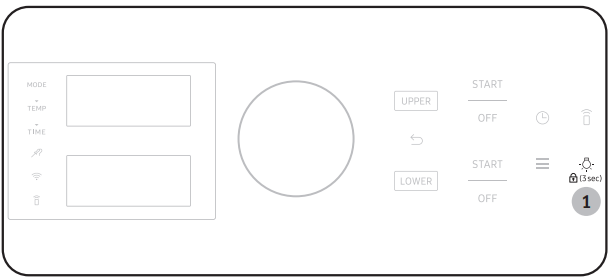 | 1. Press  for 3 seconds. The lock icon appear in the display as well as the current time. All functions must be cancelled before Lock feature is activated. This function is available only when the oven temperature is under 400 °F. for 3 seconds. The lock icon appear in the display as well as the current time. All functions must be cancelled before Lock feature is activated. This function is available only when the oven temperature is under 400 °F. |
How to unlock the oven and cooktop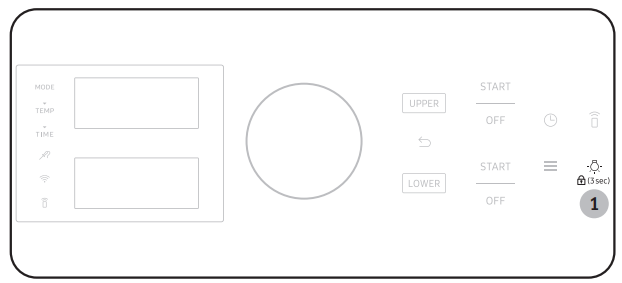 | 1. Press  for 3 seconds. The lock icon will disappear from the display for 3 seconds. The lock icon will disappear from the display |
Clock
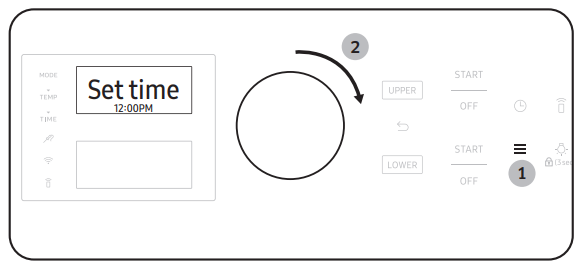 | To set the clock time
|
 | To set the Date
|
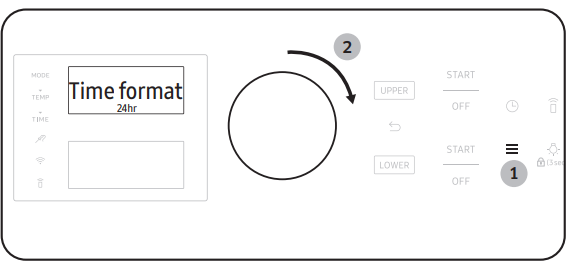 | To change the time format (12hr/24hr)
|
NOTE You can set/change the clock or the kitchen timer before you start a cooking mode or while most cooking modes are operating. However, you cannot set or change the time if a time based function is operating (Time Bake, for example) or the Sabbath feature is enabled.
Display mode
Sleep mode
The control panel enters Sleep mode if the oven is not used for a while.
In Sleep mode, the control panel is inactive, displaying only the time, until it is reactivated by the user.
NOTE You can adjust the control panel timeout
Wake-Up
 | To activate the control panel, turn or push the Dial Knob. User preferences are available in this mode including the timer, oven light, and/or control lock |
Turning the oven light on and off
- The oven light turns on automatically when the door is opened.
- The oven light turns off automatically when the door is closed.
- You can turn the oven light on and off manually by pressing the pad.
Dual Door™
This oven has a unique Dual Door™ that is hinged in the middle. If you have inserted the divider and divided the oven in two (so it is in Twin Mode), you only need to open the top half to access the upper oven. When you’re using the Flex Duo™ capability, you can access the top oven space much more easily and with greater energy efficiency.
How to use the upper door
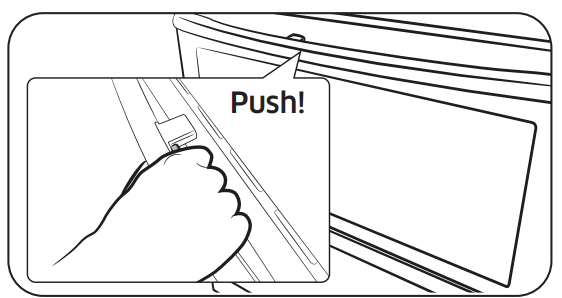 | 1. Hold the handle and the lever. Press the lever to release the door latch, and then pull the handle. |
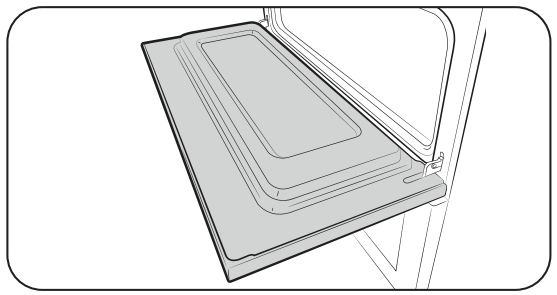 | 2. This will open only the upper door as shown |
How to use the full door
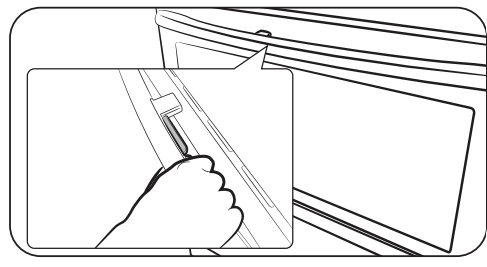 | 1. Hold the lever-less area of the handle, and then pull. |
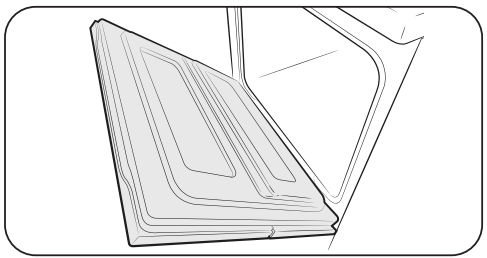 | 2. This will open the whole door as shown |
 | CAUTION When opening the whole door, make sure to grasp the handle by the lever-less portion. If you press the lever halfway through opening the whole door, the upper door may open, causing physical injury. |
NOTE
- Do not put heavy objects on, or apply excessive force, to the upper door.
- Do not let children play with or on the upper door.
Single mode
 | STEP 1 Put all ingredients in a heat-safe container. |
 | STEP 2 Select a cooking mode, and then start preheating. |
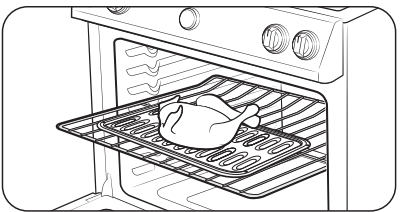 | STEP 3 Place the container on a rack. |
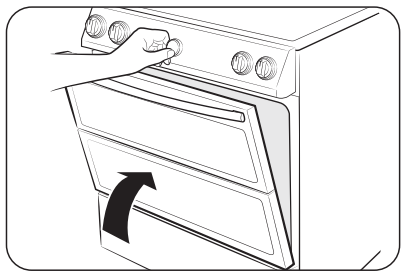 | STEP 4 Close the door and start cooking. |
NOTE
- The cooling fan automatically runs for a certain amount of time after cooking is complete.
- There can be slight popping sound during oven cooking. This sound may occur during the normal oven burner cycling, when the oven burner flame is extinguished.
Twin mode
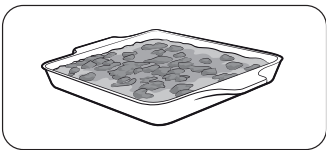 | STEP 1 Put all ingredients in a heat-safe container. |
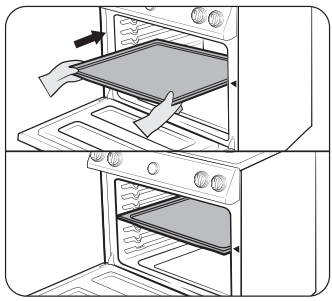 | STEP 2 Insert the divider into the 4th rack position and push in until the range beeps. |
 | STEP 3 Select a cooking mode, and then start preheating. |
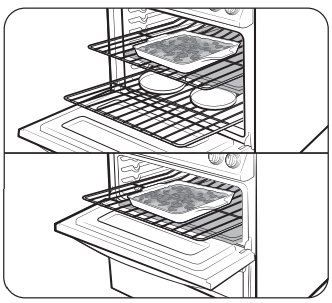 | STEP 4 Place a wire rack into the oven, arrange food containers on the racks. |
 | STEP 5 Close the door and start cooking. |
NOTE
- To use Twin mode operation, insert the divider.
- The cooling fan automatically runs for a certain amount of time after cooking is complete.
- When you are not using the divider, store it at room temperature.
- Handle the divider with both hands.
- Use oven gloves when inserting or removing the divider.
- Please note that the time for the upper and lower ovens to preheat is different.
- Do not put food containers directly on the divider for cooking purposes.

CAUTION Range displays “-dc-”
- Check the divider to see if it is installed correctly.
- Do not insert/remove the divider during cooking.
Cooking mode
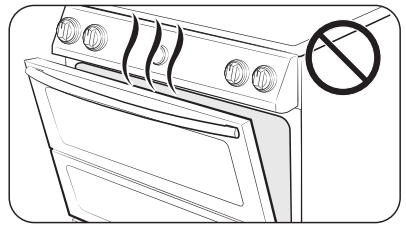 |
|
Single mode

- Use the dial knob to select a mode: (Bake, Convection Bake, Convection Roast, Air Fry, Broil, etc.).
- If necessary, use the dial knob to change the default temperature. You can set the oven to any temperature.
- Push the dial knob, if necessary, you can set the Cook Time and Delay Start when the "Start" Message displays. Tap START or push the dial knob.
- The oven preheats until it reaches the temperature you set.
- It beeps several times when it reaches the set temperature.
- When preheating is complete, place the food in the oven, and then close the door.
- When cooking is complete, turn off the oven, and then take out the food.
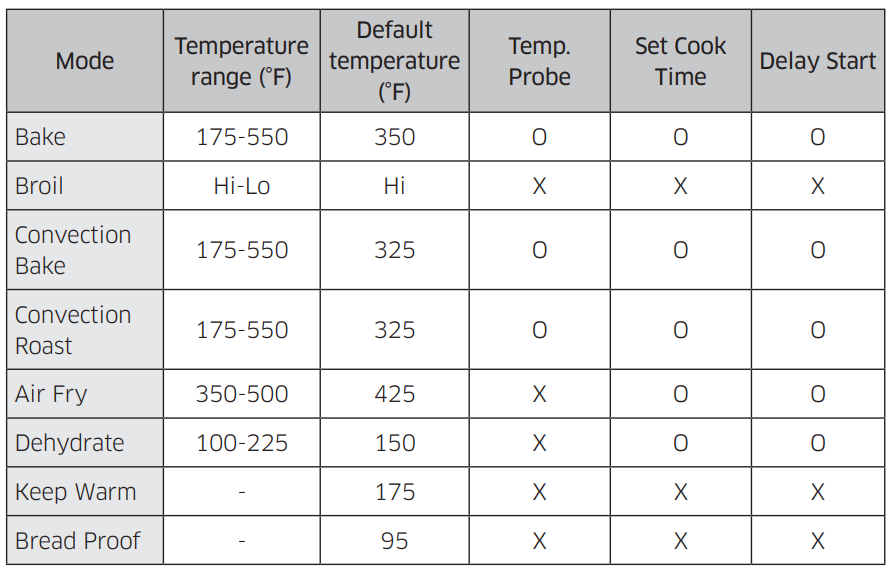
NOTE
To change the temperature during cooking, repeat steps 1 through 3 above.
NOTE
If the 12hr energy saving feature is disabled, those modes will operate until canceled. (12hr energy saving's default setting : on)
Twin mode

- Insert the divider into the cavity.
- Tap Upper or Lower to select the cooking zone.
- Select a mode using the dial knob.
- If necessary, use the dial knob to change the default temperature. You can set the oven to any temperature.
- Push the dial knob, if necessary, you can set the Cook Time and Delay Start when the "Start" Message displays. To Start mode, Tap START or push the dial knob.
- The oven preheats until it reaches the temperature you set.
- It will beep several times when it reaches the set temperature.
- When preheating is complete, place the food in the selected oven, and then close the door.
- When cooking is complete, choose the cavity and turn off the oven.
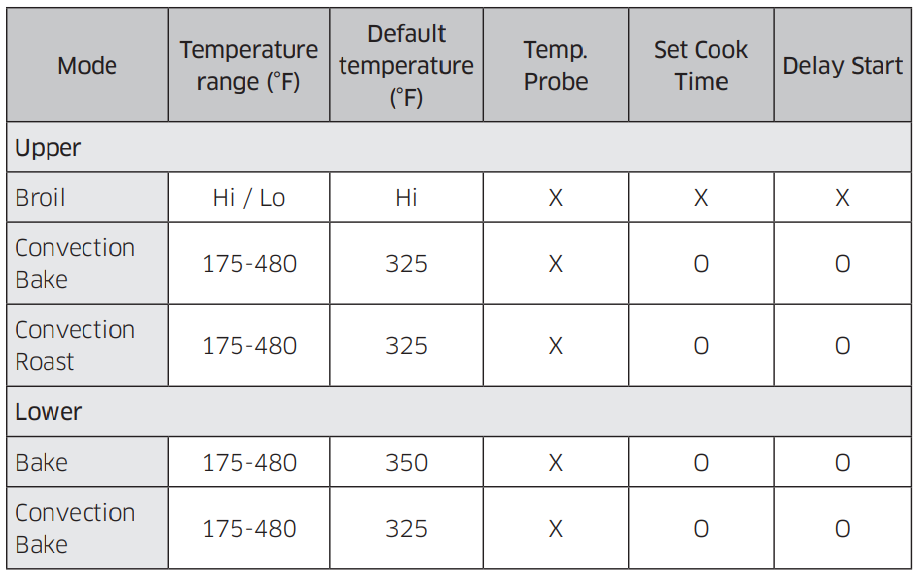
Twin Mode Temperature setting ranges
Your oven has different temperature setting ranges when you use the upper and lower oven simultaneously. The range for each oven changes, depending on the function and temperature setting of the other oven. See the tables below and on the next page for details.
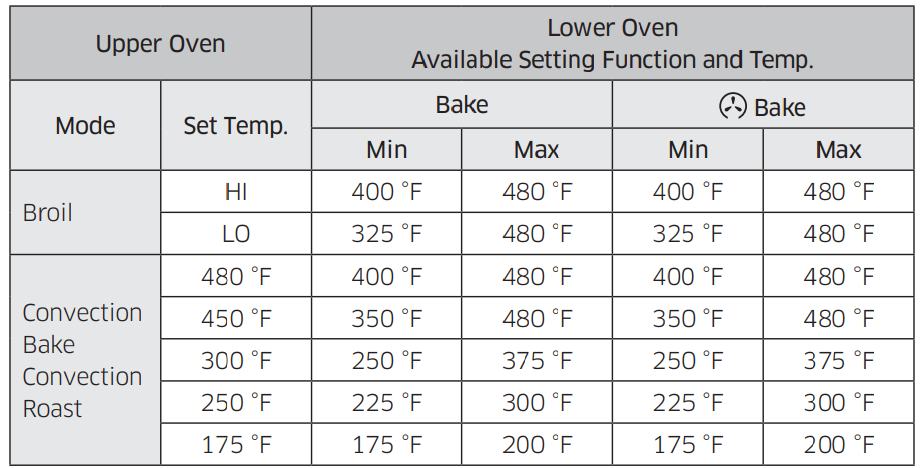
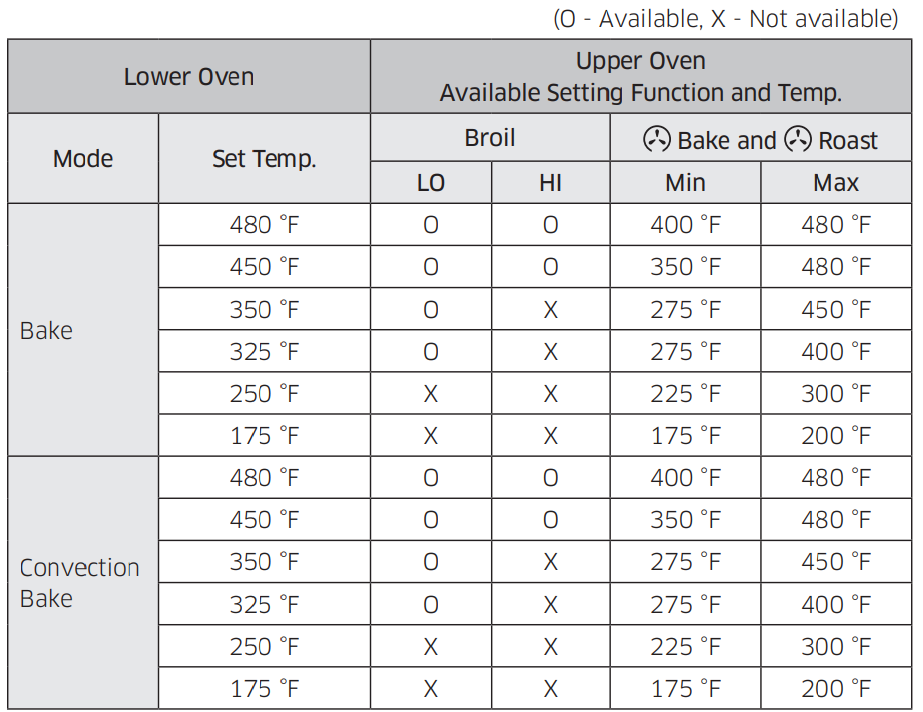
Using the oven racks
Single Mode - Full Oven
Your oven range comes with 2 racks and 7 rack positions. The rack positions are delineated by rack guides which support the racks. Each rack guide has a stop that prevents the rack from loosening during the oven's operation. Each rack has stoppers that need to be placed correctly on the rack guides. The stoppers prevent the racks from accidently coming out of the oven completely when you pull the racks out.
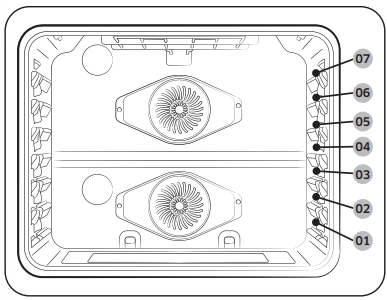 | 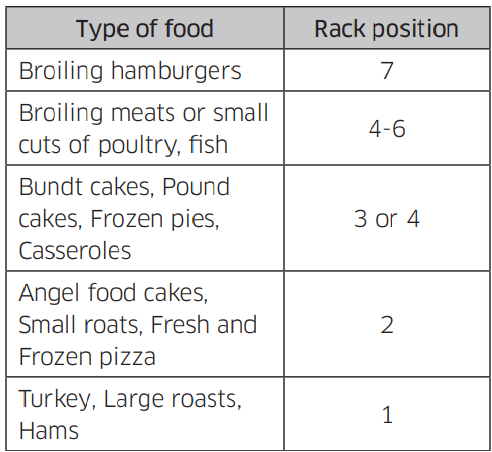 |
CAUTION
- Do not cover an oven rack with aluminum foil. This will hamper heat circulation, resulting in poor baking.
- Do not place aluminum foil on the oven bottom. The aluminum can melt and damage the oven.
- Arrange the oven racks only when the oven is cool.
- When placing an oven rack in the top-most rack position (position 7), make sure the rack is situated stably on the embossed stop.
Twin Mode - Two Ovens
In Twin mode, the divider separates the oven into an upper and lower oven. The upper and lower oven each have 3 rack positions.
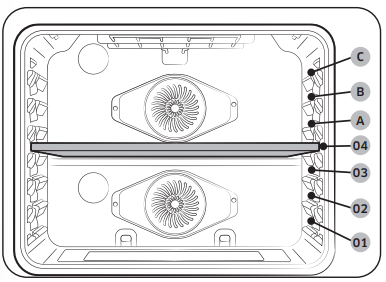
| 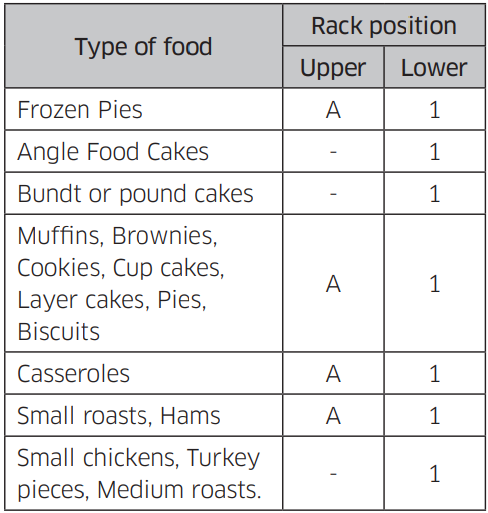 |
NOTE
- We recommend cooking pizza and pies using the 1st or 2nd rack position in Single mode or the 1st rack position of the lower oven in Twin mode for crispy bottoms.
- For simultaneous cooking in twin modes, we recommend using the gliding rack for upper oven and wire rack for lower oven.
Inserting and removing an oven rack
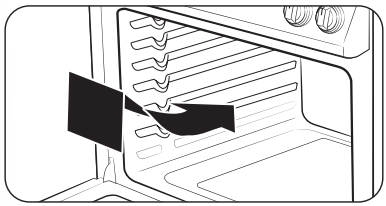 | To insert an oven rack
|
 | To remove an oven rack
|
Rack and Pan placement
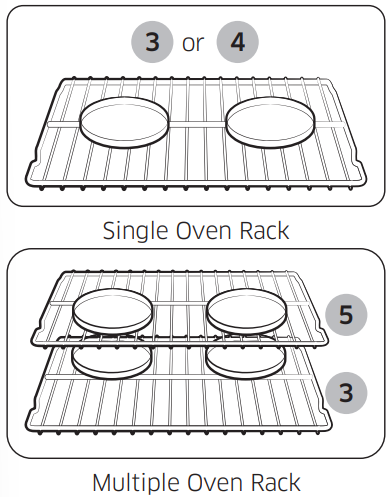 | Centering the baking pans in the oven as much as possible will produce better results. If baking with more than one pan, place the pans so each has at least 1" to 1½" of air space around it. When baking on a single oven rack, place the oven rack in position 3 or 4. See the figure on the left. When baking cakes and cookies on multiple racks, place the oven racks in positions 3 and 5. See the figure on the left. |
Using Multiple Oven Racks

Before using the racks
The rack has stops that need to be placed correctly on the supports. These stops will keep the rack from coming completely out.
REMOVING THE RACKS
- Pull the rack straight out until it stops.
- Lift up the front of the rack, and then pull it out.
REPLACING THE RACKS
- Place the end of the rack on the support.
- Tilt the front end up and push the rack in.
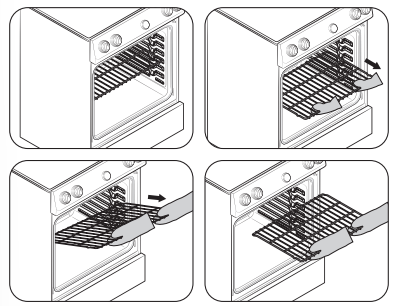 | CAUTION
|
Using the gliding rack
The fully extendable Gliding rack makes food preparation easier, especially when you are preparing heavier dishes. The Gliding rack has 2 glide tracks that allow you to extend the rack well out of the oven without touching the sides of the oven walls.
Installing the Gliding rack
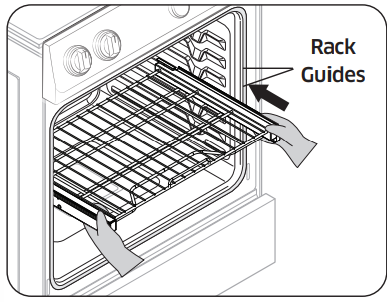 |
|
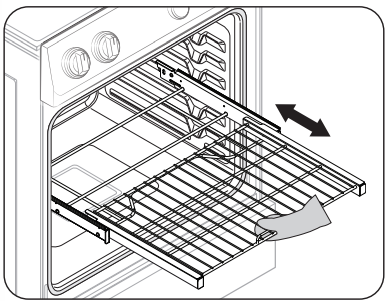 |
|
Removing the Gliding rack
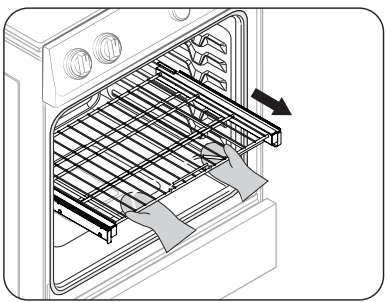 |
|
 | CAUTION Do not install the Gliding rack directly above the Flat rack. You will not be able to install it properly and the rack could fall. |
NOTE You can install the Gliding rack in any rack positions except the highest (level 7) and lowest (level 1) rack position in the oven.
Temperature probe (Single Mode Only)
Baking
Bake is used to cook cakes, cookies, and casseroles. Always preheat the oven first. Baking temperatures and times will vary depending on the ingredients, the size, and shape of the baking pan used. Dark or nonstick coatings may cook faster with more browning.
NOTE
- Place food in the oven after preheating if the recipe calls for it.
- Preheating is very important for good results when baking cakes, cookies, pastry, and breads. After the oven has reached the desired temperature, the oven will beep several times.
- If you are using an oven thermometer in the oven cavity, the temperature registered by the thermometer may differ from the actual set oven temperature.
- For performance reasons, the convection fan may be turned on or off during the operation.
Convection baking
The convection fan at the back of the oven circulates hot air evenly throughout the oven cavities so that food is evenly cooked and browned in less time than with regular heat.
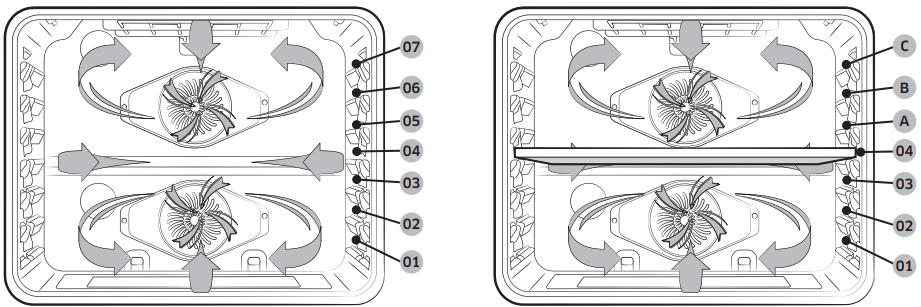
CAUTION
- The convection oven fan shuts off when the oven door is opened.
- DO NOT leave the door open for long periods of time while using convection cooking or you may shorten the life of the convection heating element.
NOTE
- When using convection cooking, always preheat the oven for the best results.
- If you leave the oven door open for more than 2 minutes when the oven is on, all heating elements will shut off automatically.
- When you have finished cooking, the cooling fan will continue to run until the oven has cooled down.
- For performance reasons, the convection fan may be turned on or off during the operation.

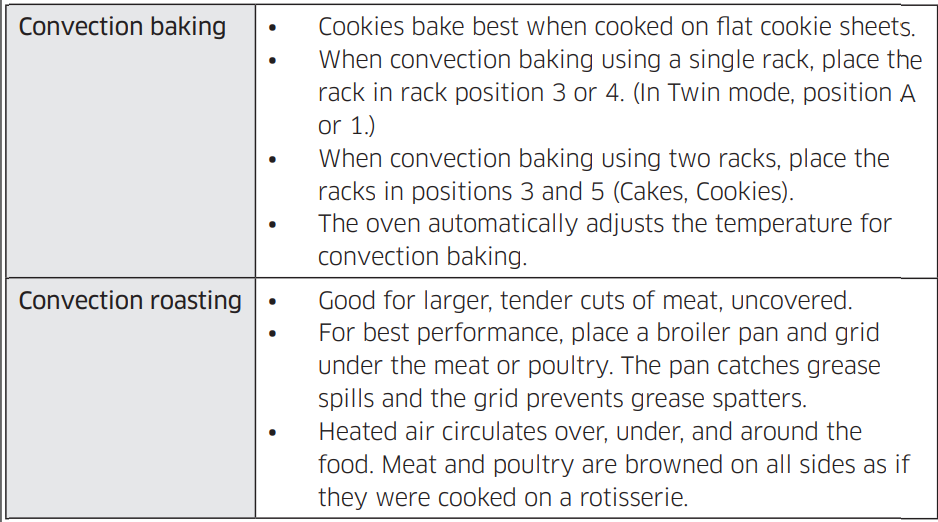
Broiling
Broiling uses the oven broil burner at the top of the oven to cook and brown food. Meat or fish must be put on a broiling grid in a broiling pan. Preheating for 4 minutes before broiling is recommended.
NOTE
- This oven is designed for closed door broiling. While broiling, keep the door closed.
- Only open the door to put food in, turn food over, or take food out.
- Use the Broil Rack for the best results.
- Use the Broil LO for poultry or thick cuts of meat to prevent overbroiling.
- Use caution when you open the oven door to turn over the food. The air escaping from the oven will be very hot.
- If you leave the oven door open for more than 2 minutes when the oven is on, all heating elements will shut off automatically.
- When you have finished cooking, the cooling fan will continue to run until the oven has cooled down.
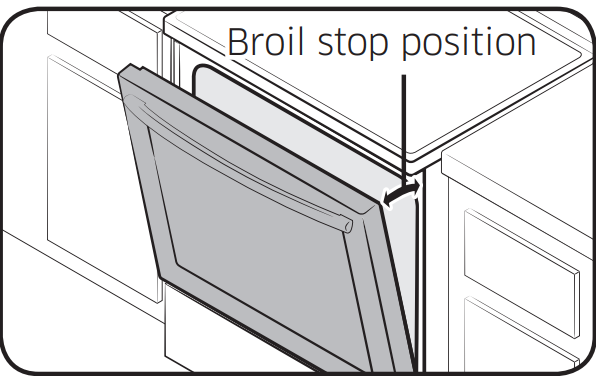
Broiling guide
NOTE
- This is for reference only.
- Preheating for 4 minutes before broiling is recommended.
- The size, weight, thickness, starting temperature, and your doneness preference will affect broiling times.
- This guide is based on meats at refrigerator temperature.

CAUTION Make sure to close the door after turning over the food.
Air fry
This feature uses hot air for crispier and healthier frozen or fresh foods without, or less oil, than normal convection modes. For best results, use this mode on a single oven rack and place the Air fry tray on the position 3. The temperature can be set between 350 °F and 500 °F. Preheating is not necessary for this mode. Follow recipe or package directions for set temperature, time, or quantity.
How to set the oven for Air fry mode
- Place the tray on rack position 3.
- Select Air fry mode using the dial knob.
- Use the dial knob to change the default temperature. Enter the suggested temperature for your food as recommended cooking guide. The default temperature is 425 °F.
- Push the dial knob and set the Cook Time or Delay Start, if necessary.
- Tap START or push the dial knob.
- When cooking is complete, tap OFF and take out the food.
 | NOTE
|
Air fry cooking guide
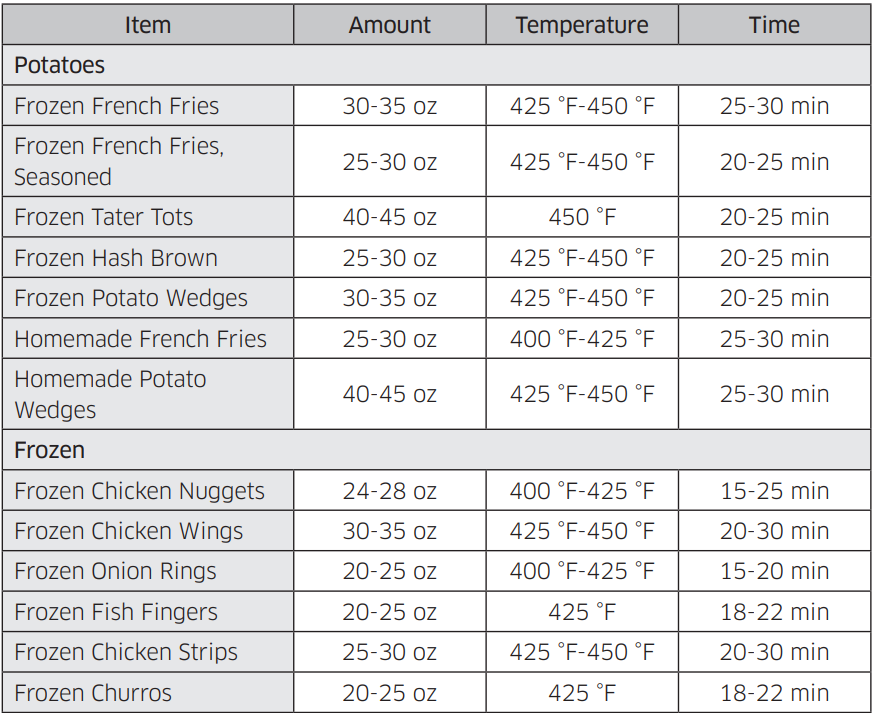
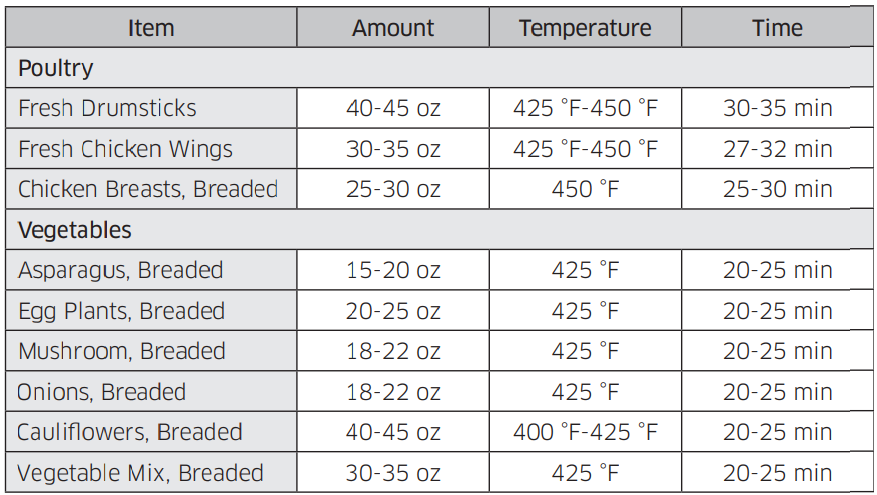
Dehydrate
Dehydrate dries food or removes moisture from food via heat circulation. After drying the food, keep it in a cool and dry place. For fruit, adding lemon (or pineapple) juice or sprinkling sugar on the fruit helps the fruit retain sweetness.
NOTE
- There is no preheating before dehydrating.
- Place the rack in rack position 3 or 4.
Bread Proof
The Bread Proof function automatically provides the optimum temperature for the bread proof process and, therefore does not have a temperature adjustment.
If you press Bread Proof when the oven temperature is above 95 °F, Hot will appear in the display. Because these functions produce the best results when started while the oven is cool, we recommend that you wait until the oven has cooled down and Hot disappears from the display.
NOTE
- There is no preheating before bread proof.
- Place the rack in rack position 3.
Keep Warm
Keeps cooked food warm at a low temperature up to 3 hours.
NOTE
- Place the rack in rack position 3 or 4.
- If turn off the 12hr energy saving feature, this modes will operate until canceled. (12hr energy saving's default setting : on)
CAUTION You should not use this feature to reheat cold food
Temperature probe (Single Mode Only)
The temperature probe lets you cook roasts and poultry to the exact internal temperature you want, taking the guess work out of determining whether a piece of meat is done or not.
You can use the temperature probe with the oven set to Bake, Convection Bake, or
Convection Roast. When you use the temperature probe, the internal temperature is shown on the display when it reaches 100 °F.
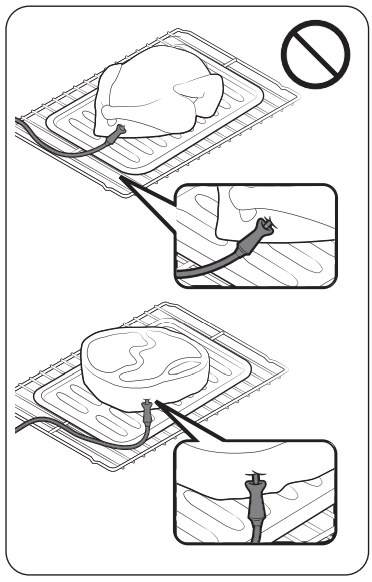 | 1. Push the temperature probe into the meat so that the tip of the probe reaches the center of the meat.
|
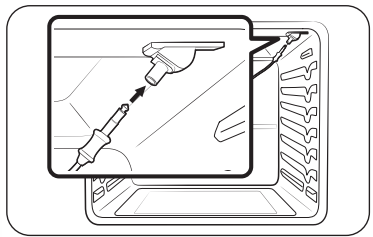 | 2. Insert the temperature probe plug into the socket on the top side wall of the oven. 3. Select the cooking operation (Convection Bake, Convection Roast, or Bake) and the temperature. 4. Set the internal temperature between 100 °F to 200 °F using the dial knob. |
 | |
5. Set an option (Delay Start) if necessary. 6 6. Tap START. When the food reaches the set internal temperature, the oven automatically shuts off, and then beeps NOTE Temperature probe operation will shut off either :
| |

CAUTION
- To protect the temperature probe, be careful not to insert the probe so that it comes out of the meat. Make sure that the probe is inserted around the center of the meat.
- Do not store the probe in the oven.
- Do not leave the probe inside the oven during the Self-Cleaning or Broiling cycle. This will cause permanent damage to the probe.
- To avoid damage to the probe, defrost food in advance.
- Do not use tongs when inserting or removing the probe. Tongs can damage the probe.
- Use the temperature probe only for the applicable cooking operations.
NOTE
If you have covered the meat with aluminum foil and you let it stand covered for 10 minutes after cooking is complete, the internal temperature increases by 5-10°F degrees.
Special features
The Sabbath feature (Single mode only)
 | (For use on the Jewish Sabbath and Holidays) Use this option only for baking on the Jewish Sabbath and Holidays. For more information, visit the website at http://www.star-k.org |
With the Sabbath feature
- The oven temperature can be set higher or lower after you have set this option.
- The display doesn’t change and no beep sounds when you change the temperature.
- Once the oven is properly set for baking with the Sabbath feature active, the oven will remain continuously on until the Sabbath feature is cancelled. This will override the factory preset 12 hour energy saving feature.
- If the oven light is needed during the Sabbath, press the pad before activating the Sabbath feature. Once the oven light is turned on and the
- Sabbath feature is active, the oven light will remain on until the Sabbath feature is turned off.
- If you want the oven light off, be sure to turn it off before activating the
- Sabbath feature.
- Do not use the surface cooktop when the Sabbath feature is on.
To enable the Sabbath feature

- Start a Bake Mode. (Single mode only.)
- Tap
 , and select the Sabbath feature.
, and select the Sabbath feature. - Turn the dial knob to select On/Off.
- Push the dial knob to save the changes.
NOTE
- You can change the oven temperature once baking starts, but the display will not change or beep. After changing the temperature, it takes 15 seconds before the oven recognizes the change.
- You can turn off the oven at any time by tapping OFF. However, this doesn’t deactivate the Sabbath feature.
- To deactivate the Sabbath feature, hold down
 for 3 seconds.
for 3 seconds. - You can set the cooking time before activating the Sabbath feature.
- After a power failure, the oven will not resume operation automatically. Sabbath” will appear in the control panel, but the oven will not go back on. Food can be safely removed from the oven, but you should not turn off the Sabbath feature and turn the oven back on until after the Sabbath/Holidays.
- After the Sabbath observance, turn off the Sabbath feature by pressing and holding
 for at least 3 seconds.
for at least 3 seconds.
CAUTION
- Do not attempt to activate any other functions except for Bake when the Sabbath feature is on. Only the following functions will function properly: Bake, Oven Start/Set, and Oven Off.
- Do not open the oven door or change the oven temperature for about minutes after you have started the Sabbath feature. Let the oven reach the set temperature. The oven fan operates only when the oven temperature increases.
More functions
Tap the button  on the control panel, and then turn the dial knob to change various settings for your oven. Please refer to the following table for detailed descriptions. The Options menu is available only when the oven is off.
on the control panel, and then turn the dial knob to change various settings for your oven. Please refer to the following table for detailed descriptions. The Options menu is available only when the oven is off.



Timer
The timer gives you an extra timer you can use to time cooking tasks, such as boiling eggs. It does not, however, start or stop any cooking operation. You can set the timer from 1 minute to 9 hours and 59 minutes.
- Tap
 . To select Timer using the dial knob.
. To select Timer using the dial knob. - Enter a desired time using the dial knob.
- When done, push the dial knob.
- To cancel the Timer settings, push or turn the dial knob. To select cancel using the dial knob.
- When the set time elapses, the oven beeps and displays the “Time's up.” message. Count up timer starts after finishing Timer. Push the dial knob, count up timer will be disappeared.
Favorites
You can add up to 10 frequently used cook settings to the Favorites list to easily apply them in the future. Adding the new cook settings to the Favorites
- Tap
 , and select Favorites using the dial knob.
, and select Favorites using the dial knob. - Set the cook setting (Mode, Temperature, Cook Time, Probe Temp).
- If necessary, select option (Cook Time and Probe Temp).
NOTE
Alternatively, you can simply tap Add to Favorites that appears when the oven completes cooking.
Editing the favorite cook settings
- Tap
 , and select Favorites using the dial knob.
, and select Favorites using the dial knob. - Select Edit.
- Change the cook settings. Items appear on the list may change upon what you select. (Cook mode, temperature, Cook Time, etc.)
Deleting the favorite cook settings
- Tap
 , and select Favorites using the dial knob.
, and select Favorites using the dial knob. - Select Delete.
- Select the favorite cook setting you want to delete.
Using the favorite cook settings
- To select Favorites Mode using the dial knob.
- Select the favorite cook setting you want to start.
- Tap START.
My Mode List
You can edit the mode lists.
- Tap
 , and select My Mode List using the dial knob.
, and select My Mode List using the dial knob. - Turn the dial knob to select or unselect modes.
- Select Save to save the changes.
Auto Conversion
Auto Conversion automatically converts regular baking temperatures to convection baking temperatures. For example, if you enter a regular recipe temperature of 350°F and tap START, the oven displays the converted temperature of 325 °F.
- Tap
 , and select Auto Conversion using the dial knob.
, and select Auto Conversion using the dial knob. - Turn the dial knob to select On/Off. (Default setting is “Off”.)
- Push the dial knob to save the changes.
Screen Timeout
You can set the length of time before the screen saver turns on.
- Tap
 and select Screen Timeout using the dial knob.
and select Screen Timeout using the dial knob. - Turn the dial knob to select setting time.
- Push the dial knob to save the changes.
NOTE
Energy consumption may increase depending on your setting.
When the timeout setting is set to "Always on", the brightness of the LCD automatically changes to level 2 if there is no action for 3 minutes.
12hr energy saving
This will automatically turn off the oven 12 hours after baking starts or 3 hours after broiling starts.
- Tap
 , and select 12hr energy saving using the dial knob.
, and select 12hr energy saving using the dial knob. - Turn the dial knob to select On/Off.
- Push the dial knob to save the changes.
Sound
Turn sound (beeps) On/Off.
- Tap
 , and select Sound using the dial knob.
, and select Sound using the dial knob. - Turn the dial knob to select On/Off.
- Push the dial knob to save the changes.
System Settings
Tap and hold  for 3 sec, on the control panel, and then Turn the dial knob to change various settings for your oven. Please refer to the following table for detailed descriptions
for 3 sec, on the control panel, and then Turn the dial knob to change various settings for your oven. Please refer to the following table for detailed descriptions
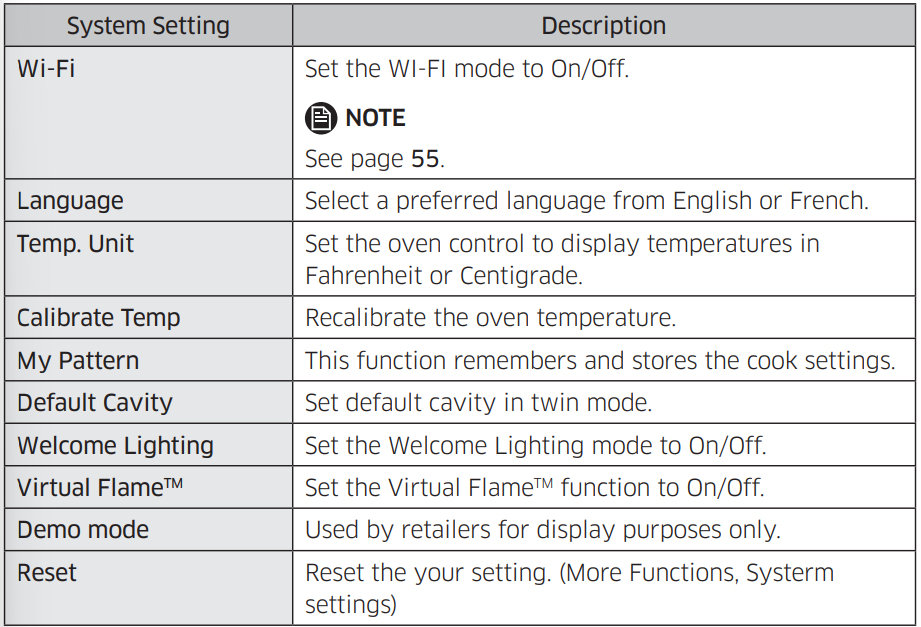
Language
Select a preferred language from English, or French. You can not change the language during cooking.
- Tap and hold
 for 3 sec.
for 3 sec. - Select the Language using the dial knob.
- Turn the dial knob to select the Language and push to save the changes.
Temp. Unit (°F / °C)
Change the temperature format of the oven to Fahrenheit or Celsius.
The default is Fahrenheit.
- Tap and hold
 for 3 sec.
for 3 sec. - Select Temp. Unit using the dial knob.
- Turn the dial knob to select unit and push to save the changes.
Calibrate Temp
The oven temperature has been calibrated at the factory. When first using the oven, follow the recommended recipe times and temperatures. If it appears that the oven is too hot or too cool, you can recalibrate the oven temperature. Before recalibrating, test a recipe by using a temperature setting that is higher or lower than recommended. The baking results should help you decide how much of an adjustment is needed. The oven temperature can be adjusted by ±35 °F (±19 °C).
- Tap and hold
 for 3 sec.
for 3 sec. - Select Calibrate Temp using the dial knob.
- Turn the dial knob to adjust temperature value.
- Push the dial knob to save the changes.
NOTE
This adjustment does not affect the broiling or the self-cleaning temperature, and is retained in memory after a power failure.
My Pattern
This function remembers and stores the cook settings frequently used by the user.
- Tap and hold
 for 3 sec.
for 3 sec. - Select My Pattern using the dial knob.
- Turn the dial knob to select On/Off and push to save the changes.
Default Cavity
One cavity will be selected as a default in twin mode when oven turns on.
- Tap and hold
 for 3 sec.
for 3 sec. - Select Default Cavity using the dial knob.
- Turn the dial knob to select Upper or Lower and push to save the changes.
Welcome Lighting
When you wake up the oven (such as using the dial knob, using the touch pad, open the door), the knob lights blink each to welcome you.
Set the Welcome Lighting mode to On/Off. The default is on.
- Tap and hold
 for 3 sec.
for 3 sec. - Select Welcome Lighting using the dial knob.
- Turn the dial knob to select On/Off and push to save the changes.
Virtual FlameTM
You can enable or disable the Virtual FlameTM.
- Tap and hold
 for 3 sec.
for 3 sec. - Select Virtual FlameTM using the dial knob.
- Turn the dial knob to select On/Off and push to save the changes.
Demo mode
This is used by retailers for display purposes only. In this mode, the heating element does not operate.
- Tap and hold
 for 3 sec.
for 3 sec. - Select Demo mode using the dial knob.
- Turn the dial knob to select On/Off and push to save the changes.
Reset
You can reset your oven setting(More functions, System settings).
- Tap and hold
 for 3 sec.
for 3 sec. - Select Reset using the dial knob.
- Turn the dial knob to select Cancel/Reset.
CAUTION
Before reset the oven settings, turn off all oven and cooktop functions.
Smart control
How to connect the oven
- Download and open the SmartThings app on your smart device.
- Follow the app's on-screen instructions to connect your range.
- Once the process is complete, the connected icon located on your range displays and the app will confirm you are connected.
- If the connection icon does not turn on, follow the instruction on the app to reconnect.

To control the oven remotely
- Press Smart Control appears in the display. The oven can now be controlled remotely with a connected remote device.
- Select the oven icon on the SmartThings app to open the Oven Control app.
When the app is connected to the oven, you can perform the following functions through the application
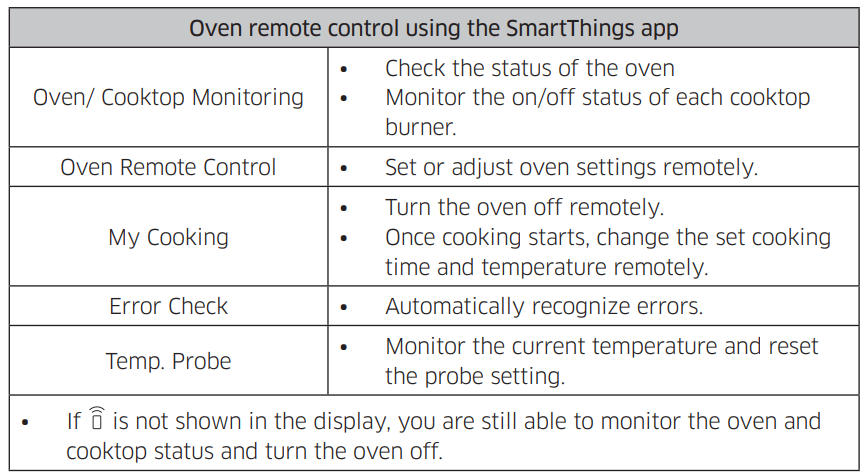
Voice control
To use the Range’s Voice Control function, you need Bixby / Amazon Alexa App / Google Assistant App on your mobile device. Refer to the table below for all available functions.
Bixby Start conversation with Bixby on SAMSUNG mobile by saying “Hi Bixby” or by pressing the side key.
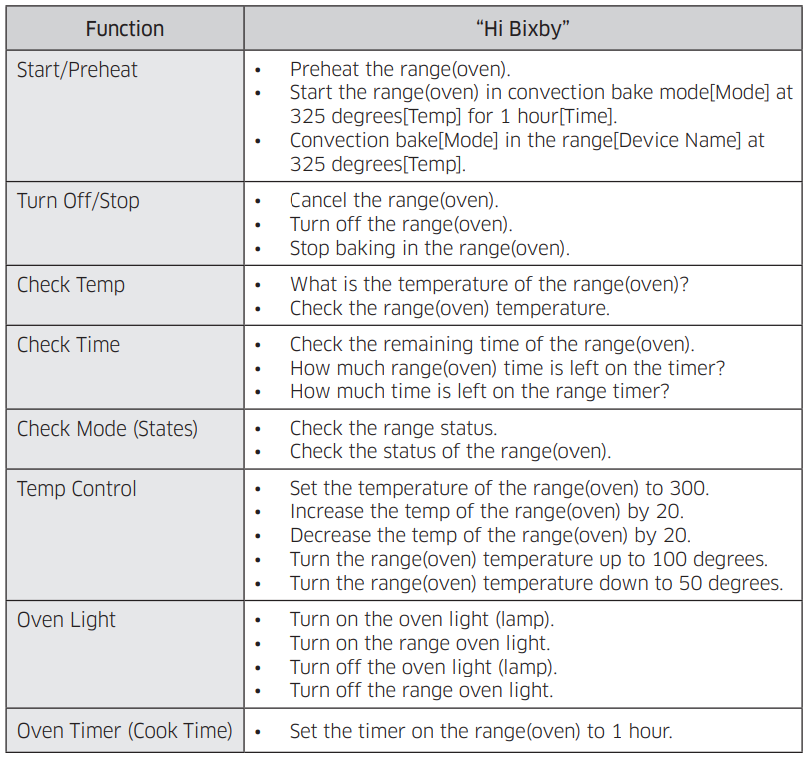
Amazon Alexa & Google Assistant
Samsung smart home appliances are supported by SmartThings skill in Alexa & action in Google Assistant.
Installation Guide
Here’s how to link SmartThings account into Amazon Alexa or Google Assistant.
SmartThings App and Alexa App(or Google Assistant App) Should be installed on your phone.
- Setup the supported devices to SmartThings.
- After device setup, tap + button on the screen.
- Tap ‘Voice assistant’ and link your Samsung account to Amazon Alexa. or Google Assistant)
- Check the devices are visible on Amazon Alexa app. Then account linking is complete. (Check the devices are visible and set the location(home&room) of devices in Google home app. Then account linking is complete.)
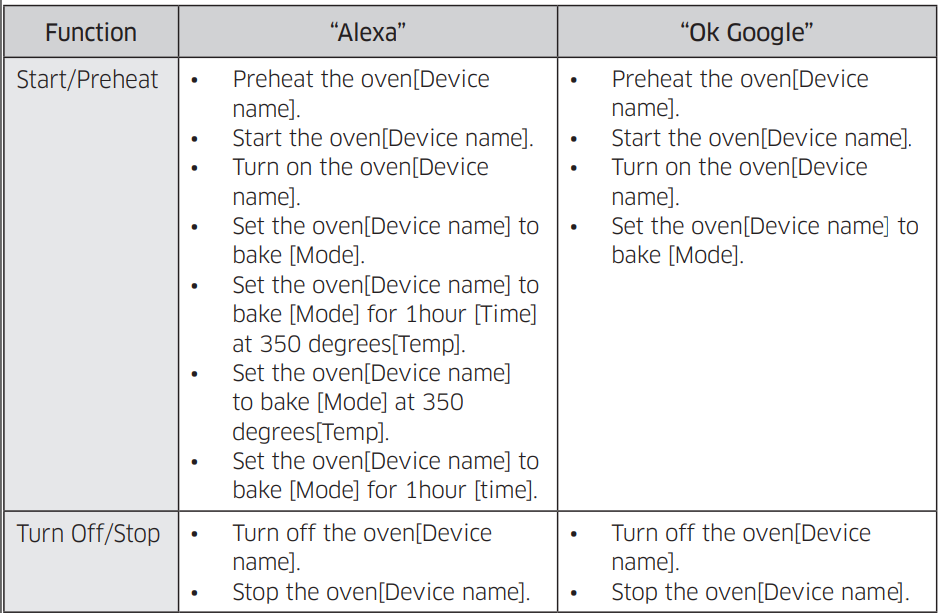
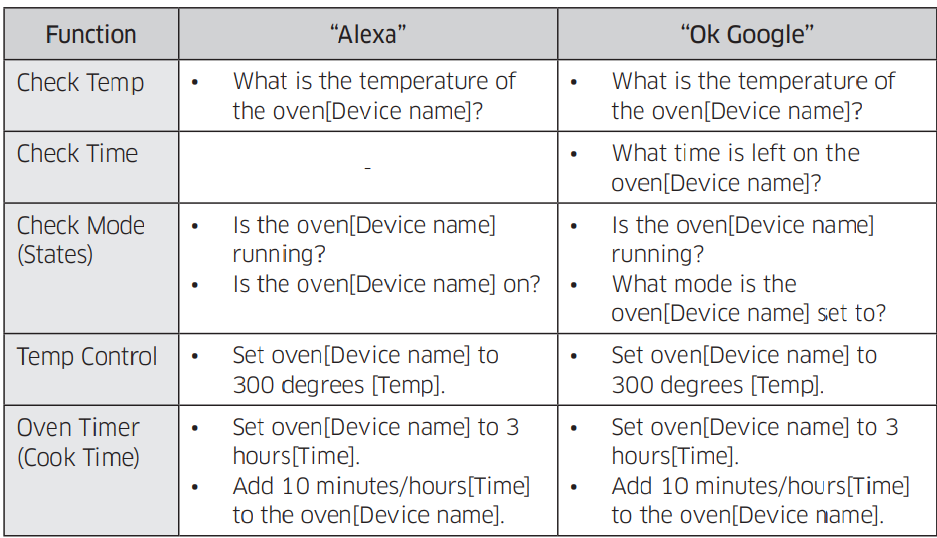
NOTE
- Only remote start function is possible. It’s impossible to deliver only setting value.
- On/Off spec of smart control is same as guided in SmartThings app.
MAINTENANCE
Self-cleaning
This self-cleaning oven uses high temperatures (well above cooking temperatures) to burn off leftover grease and residue completely or reduce them to a finely powdered ash that you can wipe away with a damp cloth.
CAUTION
- During the self-cleaning cycle, the outside of the range will become very hot to the touch. Do not leave small children unattended near the appliance.
- Some birds are extremely sensitive to the fumes given off during the selfcleaning cycle of any range. Move birds to another well-ventilated room.
- Do not line the oven walls, racks, bottom, or any other part of the range with aluminum foil. Doing so will result in poor heat distribution, poor baking results, and cause permanent damage to the oven interior. Aluminum foil will melt and adhere to the interior surface of the oven.
- Do not force the oven door open. This can damage the automatic door locking system. Use care when opening the oven door after the self-cleaning cycle is complete. Stand to the side of the oven when opening the door to allow hot air or steam to escape. The oven may still be VERY HOT.
Before a self-cleaning cycle
- We recommend venting your kitchen with an open window or using a ventilation fan or hood during the selfcleaning cycle.
- Remove the wire rack, broil pan, broil pan insert, all cookware, and any aluminum foil from the oven.
- Wipe up debris from the oven bottom.(Fig. 1)
- The silver-colored oven racks can be self-cleaned, but they will darken, lose their luster, and become hard to slide.
- Residue on the front frame of the range and outside the gasket on the door will need to be cleaned by hand. Clean these areas with hot water, soapfilled steel-wool pads, or cleansers such as Soft Scrub. Rinse well with clean water and dry.
- Do not clean the gasket. The fiberglass material of the oven door gasket cannot withstand abrasion. It is essential for the gasket to remain intact. If you notice it becoming worn or frayed, have it replaced. (Fig. 2)
- Make sure the oven light bulb cover is in place and the oven light is off.
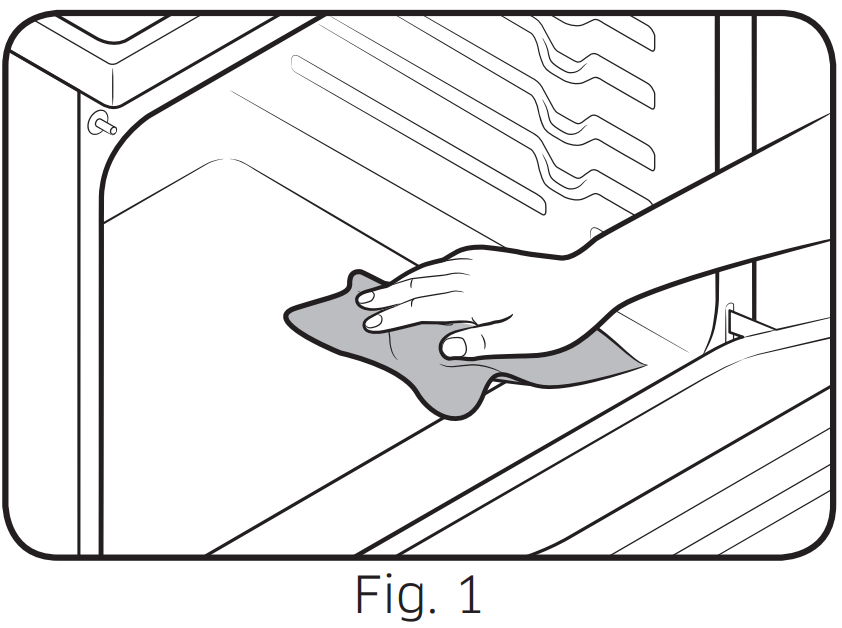 |  |
How to run a self-cleaning cycle
- Make sure the oven door is closed completely and unlocked. Turn off all oven and cooktop functions
- Tap
 , and select Cleaning > Self Clean using the dial knob. Then, select the cleaning time. (2 hour / 3 hour / 5 hour)
, and select Cleaning > Self Clean using the dial knob. Then, select the cleaning time. (2 hour / 3 hour / 5 hour) - Tap START/SET. The oven door is locked automatically and the oven begins to heat up.
- You will not be able to start a self-cleaning cycle if the control lockout feature is activated or if the oven’s temperature is too hot.
- The oven door locks automatically. The display will show the cleaning time remaining. It is not be possible to open the oven door until the temperature drops to a safe/cool temperature.
- When the self-cleaning cycle is done, End will appear in the display and the range will beep several times
How to delay the start of self-cleaning
- Repeat steps 1 and 2 on 'How to run a self-cleaning cycle'.
- Select Set Delay Start
- Set the time you want the oven to start self-cleaning using the dial knob
- Tap START/SET. The oven will start self-cleaning at your specified time.
How to turn off the self-cleaning feature
You may find it necessary to stop or interrupt a self-cleaning cycle due to smoke in the oven.
- Press OFF
- You will be able to open the oven door once the oven has cooled down for approximately 1 hour.
After a self-cleaning cycle
- You may notice some white ash in the oven. Wipe it up with a damp cloth after the oven cools. (If white spots remain, remove them with a soap-filled steel wool pad and rinse thoroughly with a vinegar and water mixture.)
- If the oven is not clean after one cycle, repeat the cycle.
- You cannot set the oven for cooking until the oven is cool enough for the door to unlock.
Steam-cleaning
How to set the oven for steam-cleaning
For light cleaning, the Steam-cleaning function saves time and energy. For heavierduty cleaning, use the self-cleaning function.
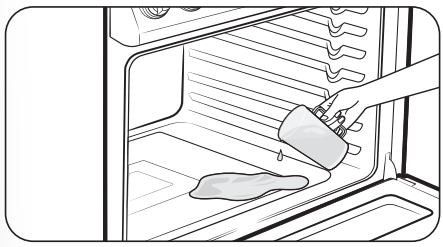 | 1. Remove all accessories from the oven 2. Pour approximately 1 ¾ cups of water onto the bottom of the empty oven and then close the oven door. Use normal water only, not distilled water. 3. Tap  , and select Cleaning > Steam Clean using the dial knob. , and select Cleaning > Steam Clean using the dial knob.4. Press START/SET. The oven door is locked automatically and the oven begins to heat up. When the operation is complete, a beep will sound. 5. Press OFF |
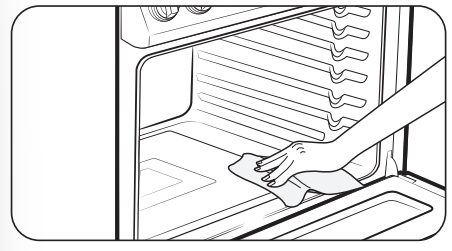 | 6. Clean the oven’s interior. There will be a significant amount of water remaining on the bottom of the oven after a steam-cleaning cycle. Remove the residual water with a sponge or soft dry cloth. |
When steam-cleaning, use exactly 10 oz. of water since this produces the best results.
NOTE
If you press Steam Clean when the oven temperature is above 100˚F, Hot will appear in the display. Because this function produces the best results when started while the oven is cool, we recommend that you wait until the oven has cooled down and Hot disappears from the display.
After a steam-cleaning cycle
- Take care when opening the door before a steam-cleaning procedure has ended. The water on the bottom is hot.
- Open the oven door and remove the remaining water with a sponge. Do not leave the residual water in the oven for any length of time. Wipe the oven clean and dry with a soft cloth. Do not forget to wipe under the oven door seal.
- Use a detergent-soaked sponge, a soft brush, or a nylon scrubber to wipe the oven interior. Remove stubborn residue with a nylon scourer. You can remove lime deposits with a cloth soaked in vinegar.
- If the oven remains dirty, you can repeat the procedure once the oven has cooled.
- For heavy residue, such as grease left over from roasting, we recommend that you rub detergent into the residue before activating the steam-cleaning function.
- After cleaning, leave the oven door ajar at a 15 ° angle to allow the interior enamel surface to dry thoroughly
Care and cleaning of the oven
WARNING
- Be sure all controls are OFF and all surfaces are COOL before cleaning any part of the range.
- If your range is removed for cleaning, servicing, or any reason, be sure the Anti-Tip device is re-engaged properly when the range is replaced. If you fail to reengage the Anti-Tip device, the range could tip and cause serous injury.
Vent
 |
|
Cleaning painted parts and decorative trim
- For general cleaning, use a cloth with hot and soapy water.
- For more difficult residue and built-up grease, apply a liquid detergent directly onto the area and leave for 30 to 60 minutes. Wipe with a damp cloth and dry. Do not use abrasive cleaners on any of these surfaces. They can scratch.
Cleaning stainless steel surfaces
- Shake the bottle of Stainless Steel Appliance Cleaner or Polish well.
- Place a small amount of Stainless Steel Appliance Cleaner or Polish on a damp cloth or damp paper towel
- Clean a small area, rubbing with the grain of the stainless steel if applicable.
- Dry and buff with a clean, dry paper towel or soft cloth.
- Repeat as necessary.
NOTE
- Do not use a steel-wool pad. It will scratch the surface.
- If a mineral oil-based stainless steel appliance cleaner has been used before to clean the appliance, wash the surface with dishwashing liquid and water prior to using the Stainless Steel Appliance Cleaner or Polish.
Oven racks
- If the racks are left in the oven during a self-cleaning cycle, their color will turn slightly blue and the finish will be dull. After the self-cleaning cycle is complete and the oven has cooled, rub the sides of the racks with wax paper or a cloth containing a small amount of oil. This will help the racks glide more easily on their tracks
- Gliding racks may be cleaned by hand with an abrasive cleaner or steel wool. During cleaning, be careful not to allow water or cleaner to enter the slides on the sides of rack.
NOTE
- Do not clean in a dishwasher.
- If the rack becomes hard to remove or replace, lightly wipe the oven rack guides with cooking oil. Do not wipe cooking oil on the slides.
- If the rack becomes difficult to slide, the rack may need to be lubricated using a graphite lubricant.
NOTE
- To order graphite lubricant., call Samsung customer care at 1-800-SAMSUNG or visit our homepage (www.samsung.com/us/support, www. samsung.com/ca/support, or www.samsung.com/ca_fr/support) and reference part number DG81-01629A.
- If you want to buy directly, connect to http://www.samsungparts.com/Default. aspx.
Oven door
- Use soap & water to thoroughly clean the top, sides, and front of the oven door. Rinse well. You may use a glass cleaner on the outside glass of the oven door. DO NOT immerse the door in water. DO NOT spray or allow water or the glass cleaner to enter the door vents. DO NOT use oven cleaners, cleaning powders, or any harsh abrasive cleaning materials on the outside of the oven door.
- DO NOT clean the oven door gasket. The oven door gasket is made of a woven material which is essential for a good seal. Care should be taken not to rub, damage, or remove this gasket.
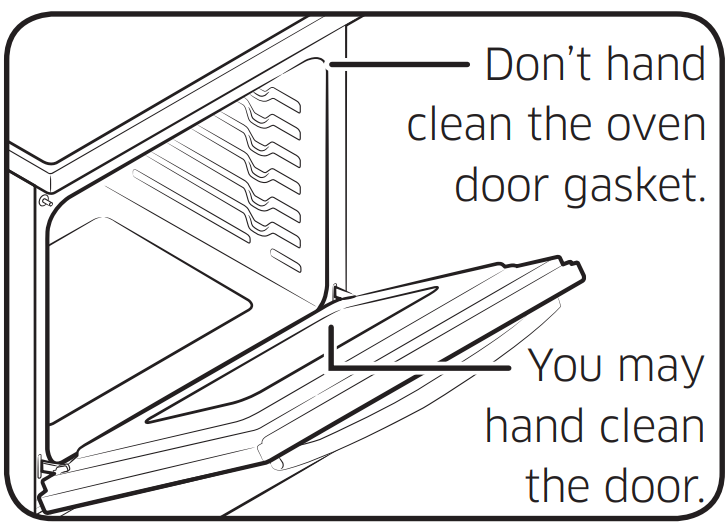
Air fry tray
To keep the Air fry tray clean, remove them from the cavity, and soak them in
Lukewarm soapy water. Then, scour soil off of the Air fry tray using a plastic scouring pad.
NOTE The air fry tray is dishwasher-safe.
CAUTION
Do not leave the air fry tray in the oven during the self-cleaning cycle. The extreme heat generated in this cycle can permanently peel off the air fry coating, their color will turn slightly blue and finish will be dull.
To lubricate the slides
 | 1. Remove the rack from the oven. See removing the gliding rack in the USING THE GLIDING RACK section. 2. Fully extend the rack on a table or countertop. Newspaper may be placed underneath the rack for easy cleanup. |
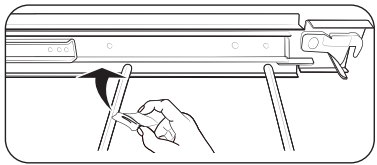 | 3. If there is debris in the slide tracks, wipe it away using a paper towel. (Any graphite lubricant wiped away must be replaced - See steps 4 through 7.) |
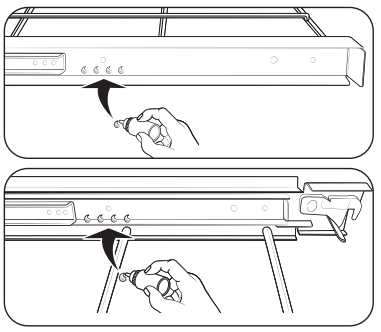 | 4. Shake the graphite lubricant before opening it. Starting with the left (front and back) slide mechanism of the rack, place four (4) small drops of lubricant on the two (2) bottom tracks of the slide close to the bearing carriers. |
 | 5. Repeat for the right (front and back) slide mechanism of the rack. 6. Open and close the rack several times to distribute the lubricant. 7. Replace the cap on the lubricant and shake it again. Turn the rack over and repeat steps 3, 4, 5 and 6. 8. Close the rack, turn rack right-side-up and place in the oven. See installing the gliding rack in the USING THE GLIDING RACK section. |
NOTE Do not spray the gliding rack with cooking spray or other lubricant sprays.
Oven door
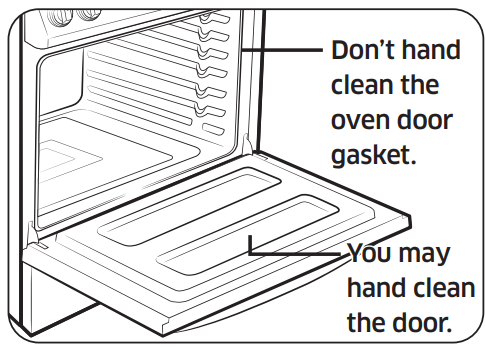 |
|
Care and cleaning of the glass cooktop
Normal daily use cleaning
Use only a ceramic cooktop cleaner. Other creams may not be as effective.
By following these steps, you can maintain and protect the surface of your glass cooktop.
- Before using the cooktop for the first time, clean it with a ceramic cooktop cleaner. This helps protect the top and makes cleanup easier.
- Daily use of a ceramic cooktop cleaner will help keep the cooktop looking new.
- Shake the cleaning cream well. Apply a few drops of cleaner directly to the cooktop.
- Use a paper towel or a cleaning pad for ceramic cooktops to clean the entire cooktop surface.
- Use a dry cloth or paper towel to remove all cleaning residue. No need to rinse.
WARNING DAMAGE to your glass surface may occur if you use scrub pads other than those recommended.
Removing burned-on residue
|
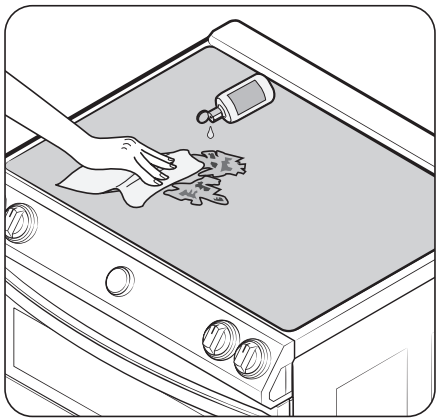
Removing heavy, burned-on residue
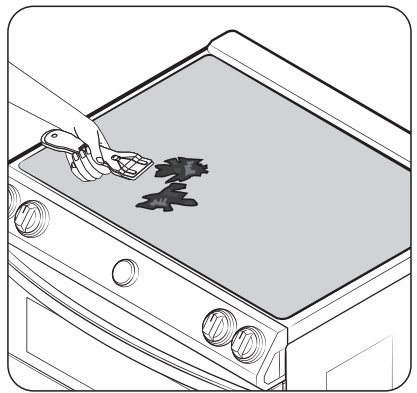
- Allow the cooktop to cool.
- Use a single-edge razor-blade scraper at approximately a 45° angle against the glass surface and scrape the soil. It will be necessary to apply pressure to remove the residue.
- After scraping with the razor scraper, spread a few drops of ceramic cooktop cleaner on the entire burned residue area. Use the cleaning pad to remove any remaining residue. (Do not scrape the seal.)
- For additional protection, after all residue has been removed, polish the entire surface with the cooktop cleaner and a paper towel.
Removing metal marks and scratches
- Be careful not to slide pots and pans across your cooktop. It will leave marks on the cooktop surface. You can remove these marks by applying ceramic cooktop cleaner with a cleaning pad for ceramic cooktops.
- If pots with a thin overlay of aluminum or copper are allowed to boil dry, the overlay may leave black discoloration on the cooktop. You should remove this discoloration immediately or it may become permanent.
WARNING Carefully check the bottoms of pans for roughness that may scratch the cooktop.
Cleaning the cooktop seal
 | To clean the seal around the edges of the glass, lay a wet cloth on it for a few minutes, then wipe clean with a nonabrasive cleaner. |
Potential for permanent damage to the glass surface
- Sugary spillovers (such as jellies, fudge, candy, syrups) or melted plastics can cause pitting of the surface of your cooktop. This is not covered under the warranty. You should clean the spill while it is still hot. Take special care when removing hot substances. Refer to the following section.
- When using a scraper, be sure it is new and the razor blade is still sharp.
Do not use a dull or nicked blade.
Cleaning sugary spills and melted plastic
- Turn off all surface units. Remove hot pans.
- Wearing an oven mitt, use a single-edge razor-blade scraper to move the spill to a cool area of the cooktop. Remove the spill with paper towels.
- Any remaining spillover should be left until the surface of the cooktop has cooled.
- Don’t use the surface units again until all of the residue has been completely removed.
NOTE If pitting or indentations in the glass surface have already occurred, the cooktop glass will have to be replaced. In this case, service will be necessary
Removing and replacing the oven door
How to remove the door
CAUTION
- The door is very heavy. Be careful when removing and lifting the door.
Do not lift the door by the handle.
- Turn the power OFF before removing the door.
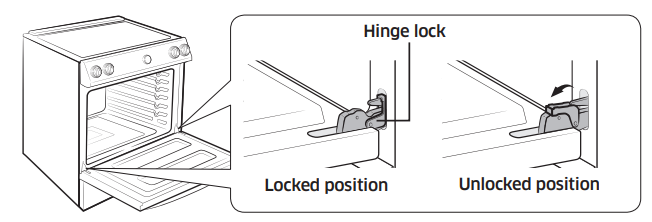
- Open the door completely.
- Pull the hinge locks down toward the door frame to the unlocked position
- Firmly grasp both sides of the door at the top.
| 4. Close the door to the door removal position, which is approximately degrees from vertical (Fig. 1). | 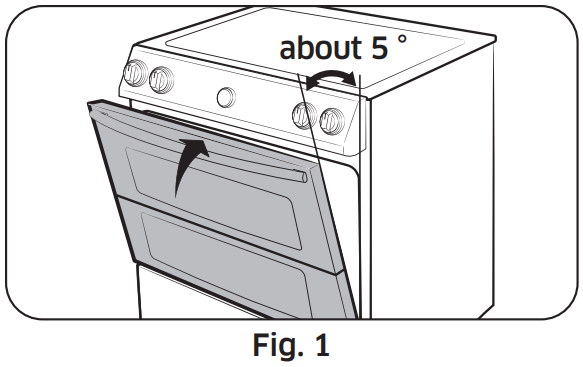 |
| 5. Lift the door up and out until the hinge arm is clear of the slot (Fig. 2). | 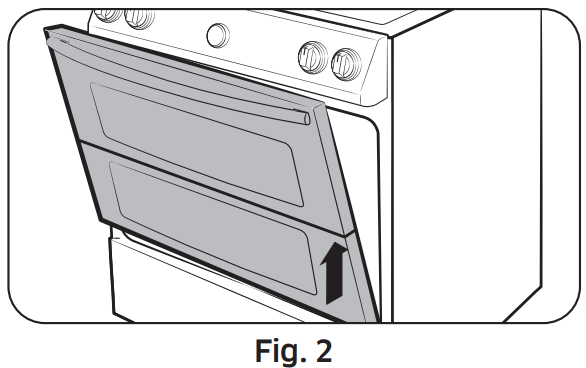 |
How to replace the door
- Firmly grasp both sides of the door at the top.
- With the door at the same angle as the removal position, slide the indentation of the hinge arm into the bottom edge of the hinge slot. The notch in the hinge arm must be fully inserted into the bottom of the slot.
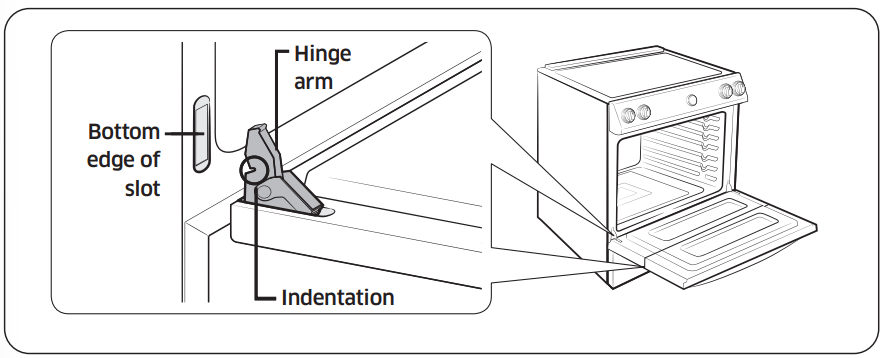
3. Open the door fully. If the door will not open fully, the indentation is not inserted correctly in the bottom edge of the slot.
4. Push the hinge locks up against the front frame of the oven cavity to the locked position.
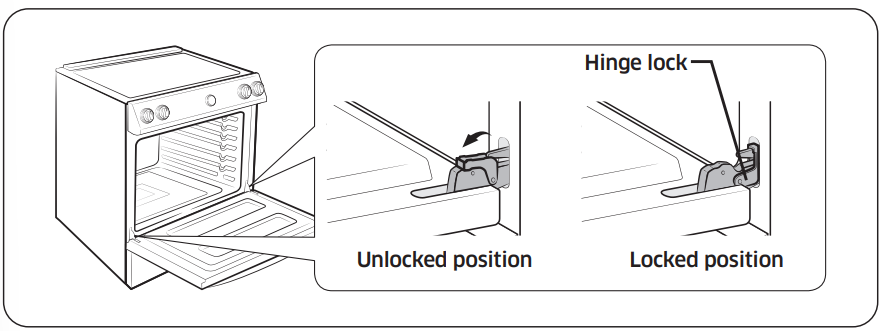
5. Close the oven door.
Removing and reinstalling the storage drawer
 | 1. Slide open the drawer until it stops. 2. Locate the roller guide clips on either side. Using both hands, pull down the left clip while lifting the right clip, and then remove the drawer. 3. Clean the drawer in warm, soapy water using a cloth or soft brush. Then, rinse and dry it thoroughly |
 | 4. Put the drawer in the roller guides on either side, and then snap the clips into place. |
Changing the oven light
The oven light is a standard 40-watt appliance bulb. It will come on when the oven door is open. When the oven door is closed, press the  pad to turn it on or off. It will not work during a self-cleaning cycle.
pad to turn it on or off. It will not work during a self-cleaning cycle.
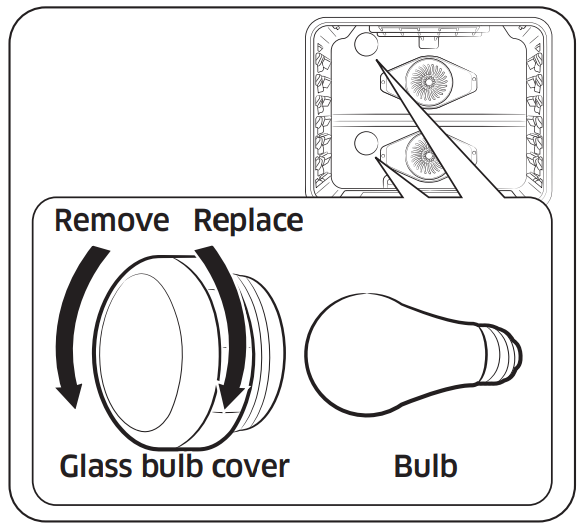
- Make sure the oven and the bulb are cool.
- Unplug the range or disconnect the power.
- Turn the glass bulb cover in the back of the oven counterclockwise to remove.
- Turn the bulb counterclockwise to remove it from its socket.
- Insert a new 40-watt appliance bulb, and then turn it clockwise to tighten. Replace the bulb cover by turning clockwise.
- Plug in the range or reconnect the power.
CAUTION Before changing your oven light bulb, disconnect the electrical power to the range at the main fuse or circuit breaker panel. Make sure the oven and the bulb are cool.
TROUBLESHOOTING
Installation
Problem | Possible cause | Solution |
The range is not level. | The appliance has been installed improperly. |
|
The floor is sagging or sloping. | Contact a carpenter to correct the situation. | |
The kitchen cabinets are not properly aligned and make the range appear to be not level. | Insure the cabinets are square and provide sufficient room for installation. | |
The appliance must be accessed for servicing and cannot be moved easily. | The kitchen cabinets are not square and too close to the appliance. | Contact a builder or installer to make the appliance accessible. |
Carpet is interfering with movement of the range. | Provide sufficient space so the range can be lifted over the carpet. |
CONTROL DISPLAY
Problem | Possible cause | Solution |
The display goes blank. | A fuse in your home may be blown or the circuit breaker tripped. | Replace the fuse or reset the circuit breaker. |
The display flashes. | There was a power failure. | Reset the clock. |
COOKTOP
Problem | Possible cause | Solution |
The surface units will not maintain a rolling boil or will not cook fast enough. | You may be using inappropriate cookware. | Use pans that are flat and match the diameter of the surface unit selected. |
In some areas, the power (voltage) may be low. | Cover the pan with a lid until the desired heat is obtained. | |
The surface units will not turn on. | A fuse in your home may be blown or a circuit breaker may have tripped. | Replace the fuse or reset the circuit breaker. |
The cooktop controls are set improperly. | Check if the correct control is set for the surface unit you are using. | |
Areas of discoloration on the cooktop. | Food spillover was not cleaned. | Refer to the section on the care and cleaning of the glass cooktop on page 62. |
The surface is hot and the model features a lightcolored cooktop. | This is normal. The surface may appear discolored when it is hot. This is temporary and will disappear as the glass cools. | |
The surface unit frequently cycles on and off. | The element will cycle on and off to maintain the power setting. | This is normal operation, and not a system failure. Use the range as usual. |
The surface unit stops glowing when changed to a lower setting. | This is normal. The unit is still on and hot. | |
Scratches or abrasions on the cooktop surface. | The cooktop is being cleaned improperly. | Scratches are not removable. Tiny scratches will become less visible in time as a result of cleaning. Use ceramic glass top cleaning cream. Do not use chemical or corrosive agents. These agents may damage the surface of the product. |
Cookware with rough bottoms was used on the cooktop or there were coarse particles (e.g., salt or sand) present between the cookware and the surface of the cooktop. | To avoid scratches, follow the recommended cleaning procedures. Make sure cookware bottoms are clean before use, and use cookware with smooth bottoms. | |
Cookware has been slid across the cooktop surface. |
| |
Brown streaks or specks. | Boilovers have been cooked onto the surface. |
|
Areas of discoloration with metallic sheen. | Mineral deposits from water and food have been left on the surface of the cooktop. |
|
"Cracking" or "popping" sound. | This is the sound of the metal heating and cooling during both the cooking and self-cleaning functions. | This is normal operation, and not a system failure. Use the range as usual. |
OVEN
Problem | Possible cause | Solution |
The oven will not turn on. | The range is not completely plugged into the electrical outlet. | Make sure the electrical plug is inserted into a live, properly grounded outlet. |
A fuse in your home may be blown or a circuit breaker may have tripped. | Replace the fuse or reset the circuit breaker. | |
The oven controls have been set improperly. | See the chapter on operating the oven starting on page 31. | |
The oven is too hot. | Allow the oven to cool. | |
Incomplete service wiring. | Call for service. | |
Power outage. | Check to see if the house lights will turn on. If necessary, call your local electric company for service. | |
The oven light will not turn on. | The light bulb is loose or defective. | Tighten or replace the bulb. |
The switch operating the light is broken. | Call for service. | |
The appliance will not turn on. | The appliance is not completely plugged into the electrical outlet or a fuse in your home may be blown or a circuit breaker may have tripped. | Make sure the power cord is plugged into a live, properly grounded outlet. Check the fuse and circuit breakers. |
Incomplete service wiring. | Call for service. | |
Power outage. | Check to see if the house lights will turn on. If necessary, call your local electric company for service. | |
Problem | Possible cause | Solution |
The oven will not turn on. | The range is not completely plugged into the electrical outlet. | Make sure the electrical plug is inserted into a live, properly grounded outlet. |
A fuse in your home may be blown or a circuit breaker may have tripped. | Replace the fuse or reset the circuit breaker. | |
The oven controls have been set improperly. | See the chapter on operating the oven starting on page 31. | |
The oven is too hot. | Allow the oven to cool. | |
Incomplete service wiring. | Call for service. | |
Power outage. | Check to see if the house lights will turn on. If necessary, call your local electric company for service. | |
The oven light will not turn on. | The light bulb is loose or defective. | Tighten or replace the bulb. |
The switch operating the light is broken. | Call for service. | |
The appliance will not turn on. | The appliance is not completely plugged into the electrical outlet or a fuse in your home may be blown or a circuit breaker may have tripped. | Make sure the power cord is plugged into a live, properly grounded outlet. Check the fuse and circuit breakers. |
Incomplete service wiring. | Call for service. | |
Power outage. | Check to see if the house lights will turn on. If necessary, call your local electric company for service. | |
Food does not broil properly. | The serving size may not be appropriate. | Refer to the cooking guide for serving sizes on page 44, and then try again. |
The rack has not been properly positioned. | See the broiling recommendation guide on page 44. | |
The cookware is not suited for broiling. | Use suitable cookware. | |
In some areas, the power (voltage) may be low. |
| |
The oven temperature is too hot or too cold. | The oven sensor needs to be adjusted. | See the section on adjusting the thermostat on page 53. |
The oven will not self-clean. | The oven temperature is too high to start a self-clean operation. | Allow the range to cool and then reset the controls. |
The oven controls have been set incorrectly. | See the section on selfcleaning on page 57. | |
A self-cleaning cycle cannot be started if the oven lock feature has been activated or if a cooktop element is on. | Deactivate the oven lock (see page 32). Make sure all surface elements are turned off. | |
Excessive smoking during a self-cleaning cycle. | There is excessive soiling in the oven. | Press OFF. Open the windows to rid the room of smoke. Wait until the self-cleaning cycle is cancelled. Wipe up the excessive soil and then start the self-cleaning cycle again. |
The oven door will not open after a selfcleaning cycle. | The oven is too hot. | Allow the oven to cool. |
The oven is not clean after a self-cleaning cycle. | The oven controls were not set correctly. | See the section on selfcleaning on page 57. |
The oven was heavily soiled. | Wipe up heavy spillovers before starting the selfcleaning cycle. Heavily soiled ovens may need to be selfcleaned again or for a longer period of time. | |
Steam is coming out of the vent. | When using the convection feature, it is normal to see steam coming out of the oven vent. | This is normal operation and not a system failure. Use the range as usual. |
As the number of racks or amount of food being cooked increases, the amount of visible steam will increase. | ||
A burning or oily odor is coming from the vent. | This is normal in a new oven and will disappear in time. |
|
Strong odor. | An odor coming from the insulation around the inside of the oven is normal for the first few times the oven is used. | Operate the oven empty on the bake setting at 400 °F for 1 hour. |
Fan noise. | A convection fan may automatically turn on and off. | This is not a system failure but normal operation. |
Oven fan is making a noise, or won't turn off. | The cooling fan is not visible, but you will hear it running whenever the electronics get hot and turn off when the electronics are cool. | This is normal operation to cool the oven, cooling fan automatically shuts down when the oven cools. |
Oven racks are difficult to slide. | The shiny, silver-colored racks were cleaned in a selfcleaning cycle. | Apply a small amount of vegetable oil to a paper towel, and then wipe the edges of the oven racks with the paper towel. |
DRAWER
Problem | Possible cause | Solution |
The drawer does not slide smoothly or drags. | The drawer is out of alignment. | Fully extend the drawer and push it all the way in. See page 65. |
The drawer is overloaded or the load is unbalanced. | Reduce weight. Redistribute drawer contents. | |
Excessive condensation in the drawer. | There is liquid present in the drawer. | Remove the liquid. |
Uncovered foods. | Cover food with a lid. |
Information codes
OVEN
Displayed code | Possible cause | Solution |
C-d0 | There is a short in the dial knob. | Press OFF, and then restart the oven. If the problem persists, disconnect all power to the range for at least 30 seconds and then reconnect the power. If this does not solve the problem, call for service. |
C-d1 | The door lock is misaligned. | |
C-F0 | This code occurs if communication between the Main and Sub PBA is interrupted. | |
C-F2 | This code occurs if communication between the Main and Touch is interrupted. | |
C-20 | The oven sensor is open when the oven is operating. | |
There is a short in the Oven sensor. | ||
C-21 | This code occurs if the internal temperature rises abnormally high. | |
C-22 | The sub PCB sensor is open when the oven is operating. | Press OFF, and then restart the oven. If the problem persists, disconnect all power to the range for at least 30 seconds and then reconnect the power. If this does not solve the problem, call for service. |
There is a short in the sub PCB sensor. | ||
C-23 | The temperature probe sensor is short when the oven is operating. | |
C-30 | The main PCB sensor is open when the oven is operating. | |
There is a short in the main PCB sensor. | ||
C-31 | This code occurs if the PCB temperature rises abnormally high. | Call for service |
-dC- | This code appears if the divider is inserted or removed while the oven is operating. | Make sure the divider is inserted properly, and then restart the oven. If the problem persists, disconnect all power to the range for at least 30 seconds and then reconnect the power. If this does not solve the problem, call for service. |
Bad line | This error message appears if the power cord is installed improperly. | If the power connection is plugged in improperly, that code appears on the display. Reconnect the power connection properly, and the message disappears. |
C-A2 | This code occurs if the sub PCB temperature rises abnormanlly high. | Press OFF. Check the oven vent and cooling vent. If the vent is closed, never block the vent by anything. After cooling the oven, restart the oven. If this does not solve the problem, call for service. |
COOKTOP
Displayed code | Possible cause | Solution |
 | This code occurs if communication between the Main and Inverter PBA is interrupted. | Turn the knob to Off, and then turn it to the setting you want again. If the problem persists, disconnect all power to the range for at least 30 seconds and then reconnect the power. If this does not solve the problem, call for service. |
 | The top sensor is open when the burner is operating. | Call for service |
The top sensor is short when the burner is operating. | ||
 | The IGBT sensor is open when the burner is operating. | |
The IGBT sensor is short when the burner is operating. | ||
 | This code occurs if the DC fan motor is open or locked. | |
 | Displayed if the cookware on an element is unsuitable or too small or no cookware has been placed on the cooking zone. | Check the cookware |
 | Displayed if an element knob was set to an On position when the Sabbath or Self-clean mode has ended or been cancelled, and the burner was not able to detect pan during 1 minute. | To return the display to normal and use the cooktop, turn the knob to the Off position. |
 | This code appears if the internal temperature of a burner rises abnormally high. | Turn the knob to Off, and then turn it to the setting you want again. If the problem persists, disconnect all power to the range for at least 30 seconds and then reconnect the power. If this does not solve the problem, call for service. |
See other models: RF23A9771SR/AA RF29A9771SR/AA RB12A300635/AA SM-G973UZWECHA WD90TA046BE/EU
 .
.